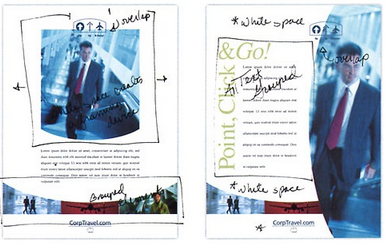Principles of Design
Unity
Unity in a composition is achieved when all design principles (balance, emphasis, proportion, contrast, and movement) have been applied
appropriately and harmony occurs among them. Unity is the hallmark of good design because aspects of the design complement one another rather than compete.
Everything you select for use in a composition must complement the key theme, and all parts must serve some functional purposes within the design.

For a composition to have a cohesive look, elements should relate to each other.
Otherwise, the design falls apart.
| Unity serves to reinforce the relationship among the design elements, and it relates them to the key theme expressed. Too often, unity is overlooked; yet, it should be one of the most important design considerations. For a composition to have a cohesive look, elements should relate to each other. Otherwise, the design falls apart. |
 |
Unity produces a sense of order. The effective design has consistent sizes and shapes as well as a harmony of colour and pattern.
When striving to achieve unity ...
Consider the following:
- Repeat the key elements.
- Balance the key elements throughout the composition.
- Add some variety so that the design has its own sense of personality.
Learning to juggle the elements and principles to achieve the right mix is a key to good design.
 |
You'll know you've achieved unity when
|
|
Always have a clear objective in mind, and stay focused on that objective. If there is an element you are considering adding to a composition, determine what it contributes to the general objective. Sometimes, it should not be added to the design. Be analytical about your work and maintain objectivity at all times. Be willing to accept critiques from peers, friends, and family members. When the purpose and message you intend is understood consistently by several people, you have succeeded in using the principle of unity. The relationship of all elements should be so strong that to add or remove any one thing would hurt the design. |
 |
Consider the following:
- Group objects closely together to make them appear as if they belong together. (This allows viewers to see a pattern.)
- Apply the principles of design as the mood and/or purpose of the design dictates. (One design may be strong in balance, for example.)
Do not attempt to apply the principles equally.
- Include as much of each principle as you can into each design.
- Always add something of your own personality into your designs. (This adds character to your work.)
- Dare to violate one or more of the principles of design to promote growth in your creativity. (Experiment!)